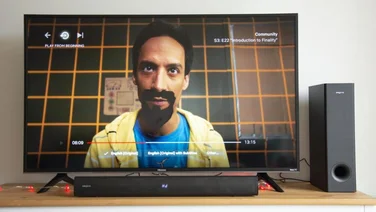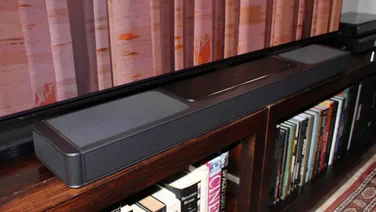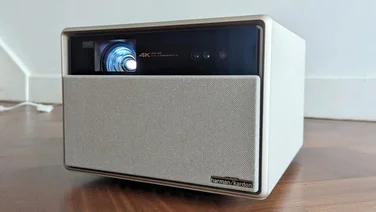To help us provide you with free impartial advice, we may earn a commission if you buy through links on our site. Learn more












- Attractive and customisable design
- Anti-reflection screen works well
- Surprisingly extensive gaming support
- Drab black levels
- Sound system lacks refinement
- Struggles with HDR colour
The modern and frankly much more stylish equivalent of the old practice of building TVs into furniture is transforming them into paintings when they’re not in use.
In principle, this process is relatively straightforward. Place a reflection-rejecting filter on a flat-screen TV, put it in a painting-style frame, and let people fill the screen with digitised artwork or photographs. Their TV set is no longer a gaping black hole on their living room wall.
The only problem with the idea of making TVs you can hang in the Louvre is that it can be difficult to combine designer looks with good picture and sound. Samsung’s ground-breaking The Frame models have finally just about cracked it, but only after years of trying. Can the Hisense Canvas – the brand’s debut in a growing market – manage to solve this conundrum at the first time of asking? Read on to find out.
| Hisense Canvas: Key specifications | |
|---|---|
| Screen sizes available | 55in 55S7N, 65in 65S7N |
| Panel type | VA Quantum Dot LCD with edge lighting |
| Resolution | 4K/UHD (3,840 x 2,160) |
| HDR formats | HDR10, HLG, HDR10+, Dolby Vision |
| Audio enhancement | Dolby Atmos, 2.0.2-channel speaker system (36W), DTS Virtual:X |
| HDMI inputs | 2 x HDMI 2.1 (1 x eARC), 2 x HDMI 2.0 |
| Freeview Play compatibility | No (but carries Freely) |
| Tuners | Terrestrial Freeview HD |
| Gaming features | 4K@144Hz, VRR, AMD FreeSync Premium, ALLM |
| Wireless connectivity | Wi-Fi 5, DLNA, Bluetooth 5.0, Apple Airplay 2, Android screen sharing |
| Smart assistants | Amazon Alexa via TV or remote, works with Google Assistant |
| Smart platform | VIDAA |
What you need to know
The Hisense Canvas TV delivers on its lifestyle design ambitions by allowing the screen to be clad in a variety of different frame styles, equipping it with anti-reflection, anti-glare filtering, and providing a selection of digital artworks you can choose to play as screensavers when you’re not watching a TV show or movie.












Despite the lifestyle focus, the Canvas TV is well specified enough to support gaming up to 144Hz with variable refresh rates, and carries Hisense’s VIDAA smart system, complete with a wide range of video streaming apps.
Price and competition
At launch, the 55in Canvas TV I’m reviewing here cost a pretty challenging £1,299. That price didn’t last long, however, and you can now get hold of one for a much more appropriate-feeling £899. Hisense recently added a 65in model to the Canvas range, which remains relatively expensive at £1,599.
While not cheap, the Canvas TV can claim a handy price advantage over its closest competition, Samsung’s The Frame. This year’s 55in model was retailing for £1,399 at the time of writing, while the larger 65in option will set you back £1,799. If you’re not married to the latest version, the 2024 iterations are priced at £839 and £999, respectively.
Design, connections and control
The Canvas TV’s design is much more critical to its appeal than it would be for a normal TV. So it’s a relief to find that, for the most part, Hisense’s design department has done a pretty decent job with it.
For starters, the so-called Hi-Matte screen’s anti-reflection filter is extremely effective. Even in a very bright room, the screen maintains a clean, reflection-free look that apes the matt, unreflective look of a canvas painting.
Out of the box, this fancy screen is held in a regular, slim black frame. However, the set ships with a natural-looking Teak-effect magnetic frame that slots cleanly over the original bezel to create that all-important painting-like look. Other frame designs are available as optional extras, including white, walnut and a selection of metallic finishes.












The Canvas TV ships with both a pair of low-profile desktop feet and an ultra-slim two-piece hanging mount that keeps its slender screen tucked right up against your wall. The wall mounting option unsurprisingly gets the most value out of the TV-as-painting concept.
When it comes to art sources to play on the Canvas, an Art Mode opens up access to 300 or so free digitised artworks, plus over a thousand more available via a VIDAA Art app subscription. Or you can play your own digital photos on the screen if you’d prefer.
The Canvas TV uses minimal power when running in Art Mode, but there’s a handy motion detection feature with a 4m operating range that can turn the screen fully off if no human presence is detected.












Connection options are pleasingly numerous for a lifestyle TV. The Canvas TV has four HDMI ports – two of which can take in 120Hz gaming signals – 2.0 and 3.0 USB ports, and an optical digital audio output alongside Wi-Fi and Bluetooth wireless connectivity.
Hisense ships the Canvas TV with a premium remote control featuring a high-gloss finish, a built-in solar panel (no new batteries required here), and a tidy metallic finish to the main navigation buttons that helps them stand out from the rest.
The TV’s set-up menus are reasonably straightforward and integrate quite smoothly into the VIDAA smart interface, but you can also circumvent them via both built-in Alexa and VIDAA voice control systems, or Google Assistant if you have an external Google Home device connected to the TV.
Smart TV platform
The Canvas TV uses Hisense’s proprietary VIDAA smart system. This is not as glamorous or intelligent in its ability to analyse your viewing habits and recommend content as some rival services, but I rather like its relative simplicity.












Plus, it carries a pretty comprehensive suite of streaming apps, including Netflix, Prime Video, Apple TV+, Disney+, YouTube, the BBC iPlayer, ITVX, All4, My5, Paramount+, Now TV and even the new Freely service. Freely lets you stream many of the Freeview service channels over your internet connection rather than having to watch them through an aerial, as well as providing access to tens of thousands of hours of catch-up content.
Helpfully, the Canvas TV supports all four of the main HDR formats: HDR10, HLG, HDR10+ and Dolby Vision. This means that it will automatically take in the best available version of any streaming (or external) source.
Image quality
As with most modern TVs, the Canvas is very much designed (on paper) with high dynamic range playback in mind. Yet it proves much more at home with the relatively mild demands of SDR content.
If accuracy is your thing, the Canvas TV’s Filmmaker Mode can deliver more of that, at least with SDR colour, than I’d expected from a TV potentially built more with lifestyle design considerations in mind than picture quality. Measurements using Portrait Displays’ Calman Ultimate software, C6 HDR5000 colour meter and G1 signal generator show Delta E average errors against the SDR Rec 709 standard for RGB saturation and luminance sweeps of 3.8 and 2.7, respectively. A result of three or lower is generally thought to be imperceptible to the human eye, so these are decent scores. There’s coverage of 99.7% of the Rec 709 colour spectrum, too.












The Canvas TV didn’t perform as well in our multipoint greyscale SDR tests, recording a Delta E average error of 5.5 in its most accurate Filmmaker Mode. The reason for this is obvious during subjective viewing: poor black level and contrast. Dark shots consistently appear with a distinct veil of greyness hanging over them, even in the relatively brightness-limited Filmmaker Mode.
Initially, I wondered if this greyness might be a result of the Filmmaker Mode doing its usual thing of turning off pretty much all of the TV’s picture processing systems and features. It soon became clear, though, that there’s nothing you can do that substantially improves what is a fundamental limitation in the Canvas TV’s panel. Even ramping the brightness right down just dimmed the bits of the image you want to see, leaving the grey wash over everything looking largely unchanged.
Fortunately, not everything you watch is dark. A lot of popular SDR content is brightly lit daytime TV fodder, and this can look quite pretty on the Canvas; accurate and balanced in Filmmaker mode, or vibrant and bright in the default Standard mode.












Given that the Standard mode goes for a 456cd/m2 white level for its SDR presentation versus the 292cd/m2 chosen for SDR Filmmaker Mode, the Standard mode doesn’t retain anything like the accuracy of Filmmaker Mode. My various Calman colour tests reveal Delta E average errors in the 10-13 realm. But within its generally less accurate but punchier world, the Standard mode colours still retain enough balance and tonal subtlety to feel compelling, providing a good option for bright room viewing.
The Canvas TV manages to upscale HD sources to its native 4K resolution reasonably well, too, adding a nice degree of sharpness and detail without colours slipping or grain becoming exaggerated. Static 4K SDR content playback looks sharp as well, and this holds true with dark scenes despite the limited black levels.
A bit of motion blur can creep into action scenes and sports footage, but overall, while dark scenes can be a struggle, bright SDR footage on the Canvas TVs can be pretty easy to live with, if not exactly spectacular.
HDR performance
The extra brightness and light range required for high dynamic range playback sees the Canvas TV’s contrast problems escalate to a whole other level. Dark scenes look grimly grey, with anything that should look black turning a shade of green or almost glowing grey, no matter which picture setting you choose. This immediately makes dark HDR scenes look much more insipid and unrealistic than bright ones, robbing HDR viewing of the sort of consistency any slightly demanding home cinema or TV fan is looking for.
Surprisingly, this heavy grey or green wash over dark scenes does not cause subtle shadow details to become lost in the mist. Unfortunately, though, the exact opposite thing happens, and you end up seeing stuff, including video noise, that I know (from seeing the same content on mastering monitors and superior TVs) the film’s creators never intended you to see.
The fact that changing from the more aggressive Standard picture preset to the Filmmaker Mode with HDR sources has precious little effect on this over-brightening problem again reveals just how few light-control tools the Canvas TV has in its locker. The screen’s startling freedom from reflections and glare exaggerates your awareness of its dark scene woes, too.












The level of grey/green overwash with HDR pictures also makes it pretty much impossible for colours in dark scenes to look natural. What’s more, despite Calman measurements showing that the screen can cover a respectable 96% and 73.6% of the DCI-P3 and Rec 2020 colour spectrums, colours in very bright HDR areas can look a little faded and flat. Meanwhile, skin tones become a little waxy at times as the set struggles to retain the same sort of colour tone finesse it delivered passably well in SDR mode.
While the Canvas TV manages some decently eye-catching intensity in the brightest highlights of HDR pictures, despite brightness topping out at a fairly average 595cd/m2, the lack of any real black level at the dark end of the HDR light spectrum robs the HDR experience of the contrast and punch it should enjoy on a near-600 nit screen.
As yet more proof of just how basic the Canvas TV’s light management is, the 595cd/m2 peak brightness I measured in Standard mode, as well as the 570cd/m2 I measured in Filmmaker Mode, didn’t change when using different-sized HDR test windows. A flat line you can almost viscerally feel in the set’s handling of dark HDR scenes. The bottom line is that while the Canvas can be fun to watch some of the time with SDR content, its HDR pictures are hard to enjoy for any length of time.
To test the Hisense Canvas, we used Portrait Displays’ Calman colour calibration software.
Gaming
In feature terms, at least, the Canvas TV takes gaming more seriously than might have been expected. The fact that it supports frame rates up to 144Hz through two of its HDMI ports is a great start, and it backs this up by supporting variable refresh rates right up to that 144Hz cutoff point.












The VRR support includes the AMD FreeSync Premium format, and auto low latency mode (ALLM) switching means the TV can automatically switch into its faster-response Game mode when a game is detected. This gets the time the screen takes to render graphics down to a respectable 16ms. The TV also carries a dedicated Game Bar onscreen menu display, providing access to information on the gaming signal and a few gaming aids.
Gaming on the Canvas TV can be a more enjoyable experience than watching video content, depending on how much the game you’re playing favours bright, colourful environments over dark, moody ones. However, lost detail in bright HDR areas and the familiar black level issues still end up making gaming less engaging than it normally would be with a screen equipped with so many game-friendly features.
Sound quality
The inclusion of a pair of upfiring speakers and nearly 40W of audio power in its svelte form suggests a level of ambition from the Canvas TV that sadly isn’t backed up by how it sounds.
The issue is that pretty much all of that power seems to have been poured into making the TV sound loud. More of it should have been used to provide the clarity, detail, breathing room or head room required to make such loud sounds pleasant to listen to. Dense movie soundtrack moments sometimes become painfully harsh, for instance, while high treble sounds often appear exaggerated and/or accompanied by a nasty buzz from the TV’s bodywork.












The lack of a built-in subwoofer also means that there’s precious little bass to provide all the raw volume with a convincing foundation, and the general bias towards treble sounds frequently causes what should have been subtle background effects to come stampeding to the front of the mix so you’re no longer sure about what you’re supposed to be focused on.
Keeping the Canvas TV to a fairly low volume brings more balance and composure to its sound, thankfully. But only at the expense, of course, of the sort of noise levels you’d ideally want to listen to on movie nights.
Verdict
Hisense has certainly managed to meet the design part of the Canvas TV brief. It’s a TV that successfully shapeshifts into an art installation when you’re not watching shows or movies on it.
In working so hard to tick the necessary design boxes, however, Hisense has seriously taken its eye off the performance ball.






